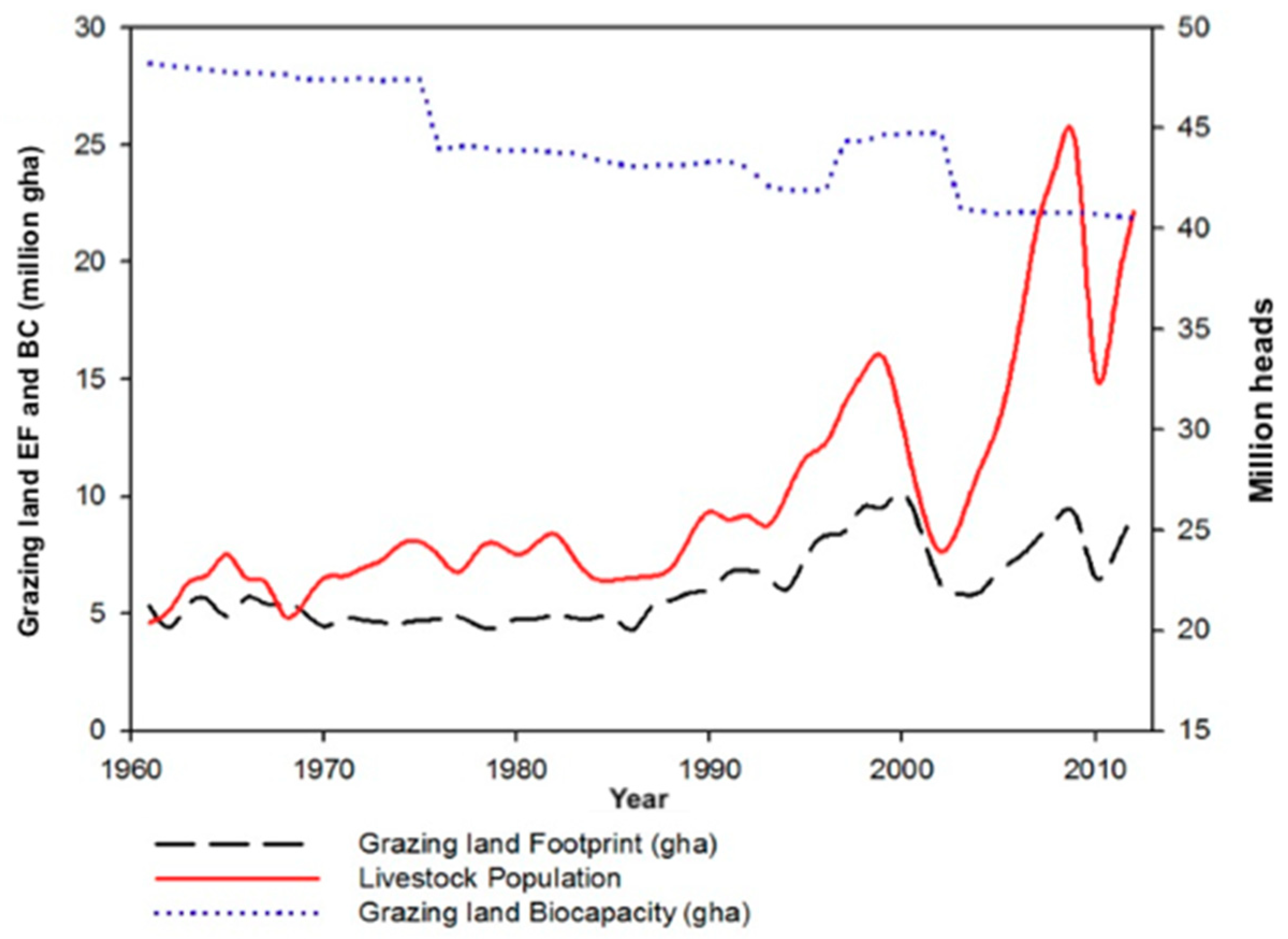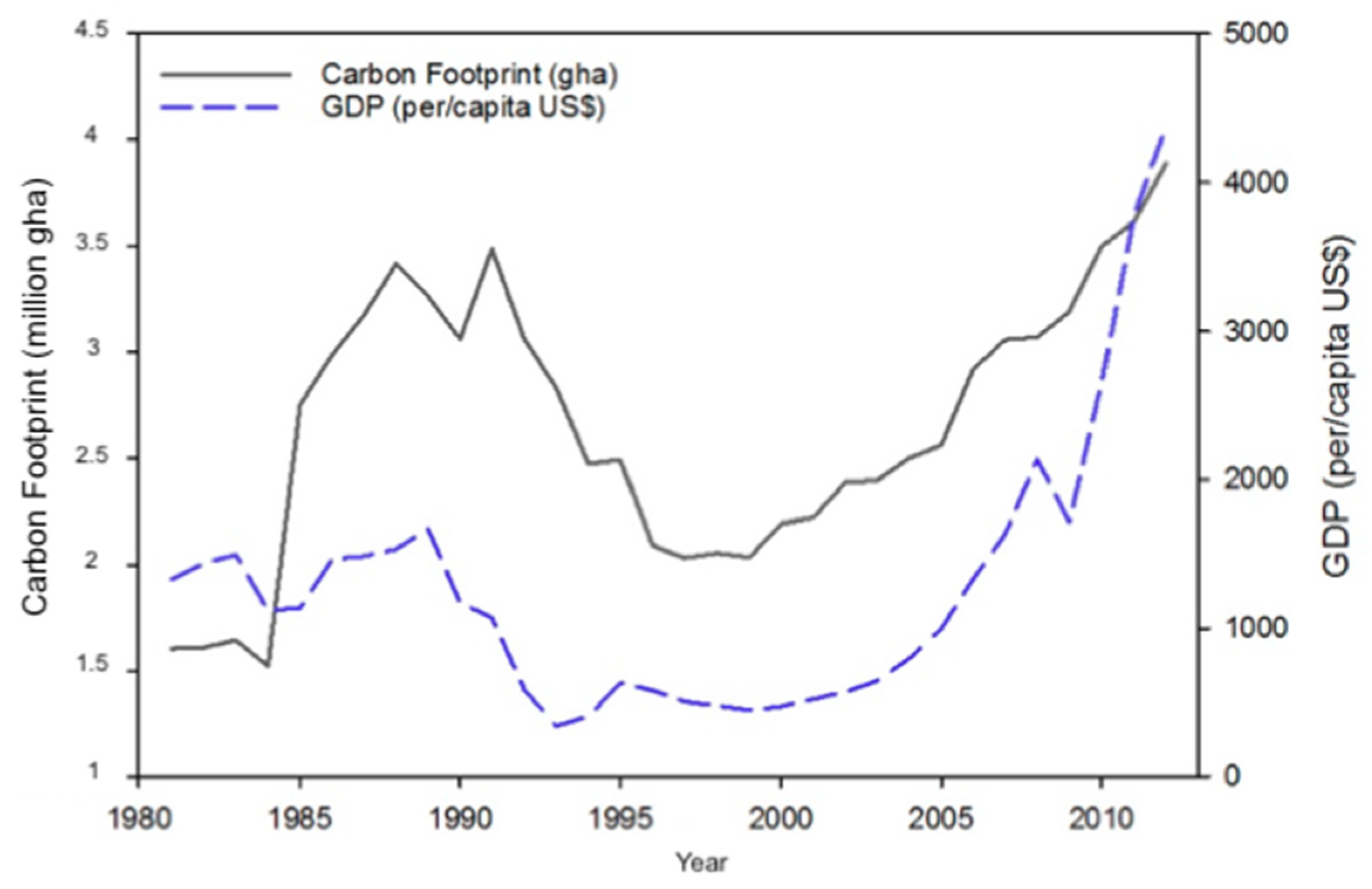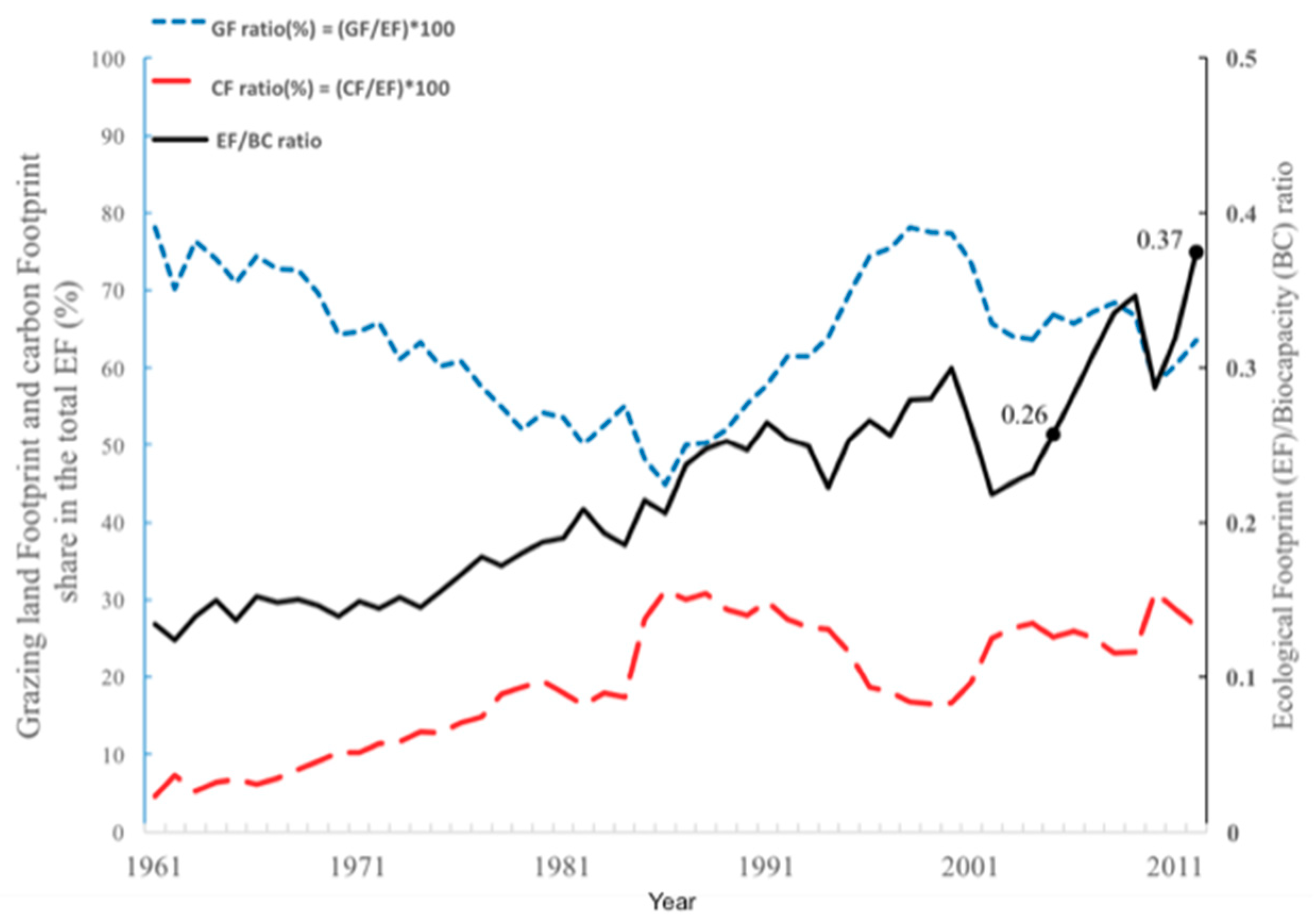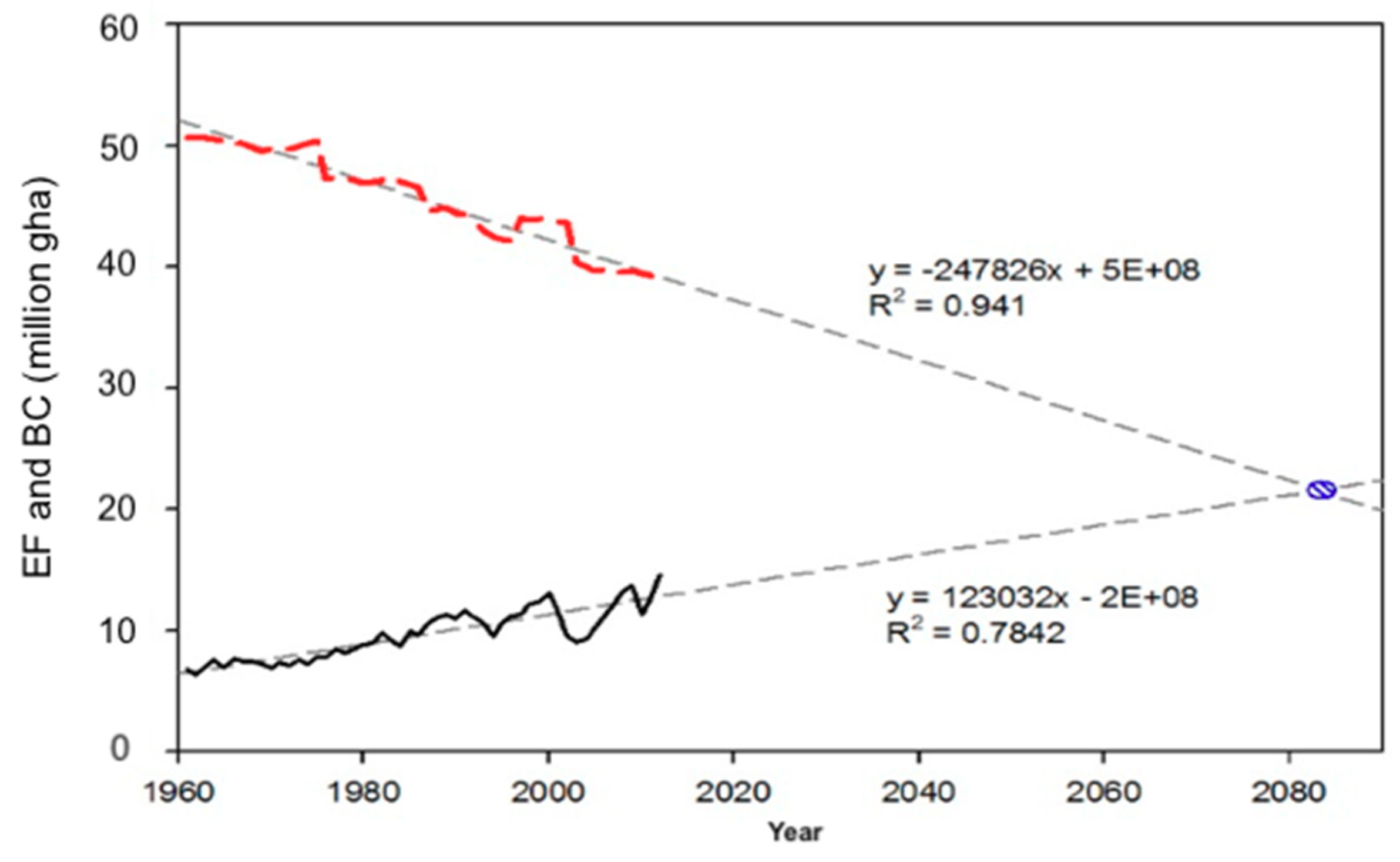Trends of Ecological Footprints and Policy Direction for Sustainable Development in Mongolia: A Case Study
Abstract
1. Introduction
2. Materials and Methods
2.1. Data and Materials
2.2. Methods
3. Results and Discussion
3.1. Variation of the Ecological Footprint
3.1.1. Grazing Land Footprint
3.1.2. Carbon Uptake Land Footprint
3.1.3. Estimated Time Span for the Ecological Deficit
3.1.4. Limitations in the Ecological Footprint Analysis
3.2. Future Policy Directions
3.2.1. Grazing Land Footprint
3.2.2. Carbon Footprint
3.2.3. Estimation of the Carbon Dioxide Reduction by Options
4. Conclusions
Author Contributions
Funding
Acknowledgments
Conflicts of Interest
References
- Dugarsuren, N.; Lin, C.; Tsogt, K. Land Cover Change Detection in Mongolia in Last Decade Using MODIS Imagery. In Proceedings of the Asian Conference on Remote Sensing, Taipei, Taiwan, 3–7 October 2011. [Google Scholar]
- National Statistical Office of Mongolia (NSO). Statistics on Population. Available online: http://www.1212.mn/statHtml/statHtml.do?orgId=976&tblId=DT_NSO_0300_003V1&conn_path=I2 (accessed on 30 September 2018). (In Mongolian).
- Lecraw, D.J.; Eddleston, P.; McMahon, A. A Value Chain Analysis of the Mongolian Cashmere Industry; Economic Policy Reform Competitiveness Project; United States Agency for International Development (USAID): Ulaanbaatar, Mongolia, 2005. [Google Scholar]
- Zhang, Y.; Nie, F.; Jiang, S.; Hu, P. Discovery of the Oyu Tolgoi copper-gold deposit in the Sino-Mongolia border region and its significance for mineral exploration. Reg. Geol. China 2003, 9, 14. [Google Scholar]
- World Bank. Country Profile for Mongolia. Available online: https://data.worldbank.org/country/mongolia (accessed on 30 September 2018).
- Noy-Meir, E. Desert ecosystems: Environment and producers. Annu. Rev. Ecol. Syst. 1973, 4, 23–51. [Google Scholar] [CrossRef]
- Batima, P.; Dagvadorj, P. Climate Change and Its Impacts in Mongolia; JEMR Publishing: Ulaanbaatar, Mongolia, 2000. [Google Scholar]
- Reynolds, J.F.; Stafford Smith, D.M.; Lambin, E.F.; Turner, B.L.; Mortimore, M.; Batterbury, S.P.J.; Downing, T.E.; Dowlatabadi, H.; Fernández, R.J.; Herrick, J.E.; et al. Ecology: Global desertification: Building a science for dryland development. Science 2007, 316, 847–851. [Google Scholar] [CrossRef] [PubMed]
- Convention on Biological Diversity (CBD). The Fifth National Report of Mongolia; Steppe Forward Programme in National University of Mongolia and Ministry of Environment and Green Development: Ulaanbaatar, Mongolia, 2014. [Google Scholar]
- Tortell, P.; Borjigdkhan, A.; Naidansuren, E. Institutional Structures for Environmental Management in Mongolia; Project MON/07/104; UNDP: Ulaanbaatar, Mongolia; Wellington, New Zealand, 2008. [Google Scholar]
- National Statistical Office of Mongolia (NSO). Mongolian Statistical Yearbook 2011; National Scientific Office of Mongolia: Ulaanbaatar, Mongolia, 2012. [Google Scholar]
- Guttikunda, S. Urban Air Pollution Analysis for Ulaanbaatar; World Bank Consultant Report; World Bank: Washington, DC, USA, 2007. [Google Scholar]
- Guttikunda, S.; Lodoysamba, S.; Bulgansaikhan, B.; Dashdondog, B. Particulate pollution in Ulaanbaatar, Mongolia. Air Qual. Atmos. Health 2013, 6, 589–601. [Google Scholar] [CrossRef]
- International Energy Agency (IEA). Coal Statistics for 2015. Available online: https://www.iea.org/sankey/#?c=Mongolia&s=Balance (accessed on 15 May 2018).
- Intended Nationally Determined Contribution (INDC). Submission by Mongolia to the Ad-Hoc Working Group on the Durban Platform for Enhanced Action, UNFCCC; INDC: Ulaanbaatar, Mongolia, 2014. [Google Scholar]
- Odum, H.T. Scales of ecological engineering. Ecol. Eng. 1996, 6, 7–19. [Google Scholar] [CrossRef]
- Odum, H.T.; Odum, B. Concepts and methods of ecological engineering. Ecol. Eng. 2003, 20, 339–361. [Google Scholar] [CrossRef]
- Kennedy, C.; Steinberger, J.; Gasson, B.; Hansen, Y.; Hillman, T.; Havranek, M.; Pataki, D.; Phdungsilp, A.; Ramaswami, A.; Mendez, G.V. Methodology for inventorying greenhouse gas emissions from global cities. Energy Policy 2010, 38, 4828–4837. [Google Scholar] [CrossRef]
- Wackernagel, M.; Onisto, L.; Bello, P.; Linares, A.C.; Falfán, I.S.L.; García, J.M.; Guerrero, A.I.S.; Guerrero, M.G.S. National natural capital accounting with the ecological footprint concept. Ecol. Econ. 1999, 29, 375–390. [Google Scholar] [CrossRef]
- Jarvis, P. Never mind the footprint, get the mass right. Nature 2007, 446, 24. [Google Scholar] [CrossRef] [PubMed]
- Wackernagel, M.; Rees, W.E. Our Ecological Footprint: Reducing Human Impact on the Earth; New Society Publishers: Gabriola Island, BC, Canada, 1996. [Google Scholar]
- Monfreda, C.; Wackernagel, M.; Deumling, D. Establishing national natural capital accounts based on detailed ecological footprint and biological capacity accounts. Land Use Policy 2004, 21, 231–246. [Google Scholar] [CrossRef]
- Wackernagel, M.; Kitzes, J.; Moran, D.; Goldfinger, S.; Thomas, M. The ecological footprint of cities and regions: Comparing resource availability with resource demand. Environ. Urban. 2006, 18, 103–112. [Google Scholar] [CrossRef]
- Borucke, M.; Moore, D.; Cranston, G.; Gracey, K.; Iha, K.; Larson, J.; Lazarus, E.; Morales, J.C.; Wackernagel, M.; Galli, A. Accounting for demand and supply of the biosphere’s regenerative capacity: The National Footprint Accounts’ underlying methodology and framework. Ecol. Indic. 2013, 24, 518–533. [Google Scholar] [CrossRef]
- Global Footprint Network (GFN). National Footprint Accounts; Global Footprint Network: Oakland, CA, USA, 2016. [Google Scholar]
- Lin, D.; Hanscom, L.; Martindill, J.; Borucke, M.; Cohen, L.; Galli, A.; Lazarus, E.; Zokai, G.; Iha, K.; Eaton, D.; et al. Working Guidebook to the National Footprint Accounts: 2016 Edition; Global Footprint Network: Oakland, CA, USA, 2016. [Google Scholar]
- Galli, A.; Wiedmann, T.; Ercin, E.; Knoblauch, D.; Ewing, B.; Giljum, S. Integrating Ecological, Carbon and Water footprint into a “Footprint Family” of indicators: Definition and role in tracking human pressure on the planet. Ecol. Indic. 2012, 16, 100–112. [Google Scholar] [CrossRef]
- Mancini, S.M.; Galli, A.; Niccolucci, V.; Lin, D.; Bastianoni, S.; Wackernagel, M.; Marchettini, N. Ecological Footprint: Refining the carbon Footprint calculation. Ecol. Indic. 2016, 61, 390–403. [Google Scholar] [CrossRef]
- National Statistical Office of Mongolia (NSO). Statistics on Livestock Population. Available online: http://www.1212.mn/statHtml/statHtml.do?orgId=976&tblId=DT_NSO_1001_005V1&conn_path=I2 (accessed on 9 April 2018). (In Mongolian).
- Ministry of Energy. Statistics Book; Ministry of Energy: Ulaanbaatar, Mongolia, 2017. (In Mongolian) [Google Scholar]
- Global Green Growth Institute (GGGI). Strategies for Development of Green Energy Systems in Mongolia; Final Report; GGGI: Ulaanbaatar, Mongolia, 2014. [Google Scholar]
- Asian Development Bank (ADB). Energy Outlook for Asia and the Pacific; Asian Development Bank: Mandaluyong, Philippines, 2015. [Google Scholar]
- Intergovernmental Panel on Climate Change (IPCC). 2006 IPCC Guidelines for National Greenhouse Gas Inventories; Prepared by the National Greenhouse Gas Inventories Programme; Eggleston, H.S., Buendia, L., Miwa, K., Ngara, T., Tanabe, K., Eds.; IGES: Kanagawa Prefecture, Japan, 2006; Volume 3. [Google Scholar]
- John, R.; Chen, J.Q.; Kim, Y.; Ou-yang, Z.T.; Xiao, J.F.; Park, H.; Shao, C.; Zhang, Y.; Amarjargal, A.; Batkhishig, O.; et al. Differentiating anthropogenic modification and precipitation-driven change on vegetation productivity on the Mongolian Plateau. Landsc. Ecol. 2016, 31, 547–566. [Google Scholar] [CrossRef]
- Lise, W.; Hess, S.; Purev, B. Pastureland degradation and poverty among herders in Mongolia: Data analysis and game estimation. Ecol. Econ. 2006, 58, 350–364. [Google Scholar] [CrossRef]
- Hilker, T.; Natsagdorj, E.; Waring, R.H.; Lyapustin, A.; Wang, Y.J. Satellite observed widespread decline in Mongolian grasslands largely due to overgrazing. Glob. Chang. Biol. 2014, 20, 418–428. [Google Scholar] [CrossRef] [PubMed]
- Asian Development Bank (ADB). Making Grasslands Sustainable in Mongolia: Adapting to Climate and Environmental Change; Asian Development Bank: Mandaluyong, Philippines, 2013. [Google Scholar]
- Rao, M.P.; Davi, N.K.; D’Arrigo, R.D.; Skees, J.; Nachin, B.; Leland, C.; Lyon, B.; Wang, S.Y.; Byambasuren, O. Dzuds, droughts, and livestock mortality in Mongolia. Environ. Res. Lett. 2015, 10, 7. [Google Scholar] [CrossRef]
- Janzen, J. Mobile livestock-keeping in Mongolia: Present problems, spatial organization, interactions between mobile and sedentary population groups and perspectives for pastoral development. Senri Ethnol. Stud. 2005, 69, 69–97. [Google Scholar]
- Liu, Y.Y.; Evans, J.P.; McCabe, M.F.; de Jeu, R.A.M.; van Dijk, A.; Dolman, A.J.; Saizen, I. Changing climate and overgrazing are decimating Mongolian steppes. Changing climate and overgrazing are decimating Mongolian steppes. PLoS ONE 2013.
- Fratkin, E.; Mearns, R. Sustainability and pastoral livelihoods: Lessons from East African Maasai and Mongolia. Hum. Organ. 2003, 62, 112–122. [Google Scholar] [CrossRef]
- Sternberg, T. Unravelling Mongolia’s extreme winter disaster of 2010. Nomadic Peoples 2010, 14, 72–86. [Google Scholar] [CrossRef]
- Fensham, R.J. Grassy vegetation of the Darling Downs, southeastern Queensland, Australia: Floristics and grazing effects. Biol. Conserv. 1998, 84, 301–310. [Google Scholar] [CrossRef]
- Bertiller, M.B. Grazing effects on sustainable semiarid rangelands in Patagonia: The state and dynamics of the soil seed bank. Environ. Manag. 1996, 20, 123–132. [Google Scholar] [CrossRef]
- Zhou, X.; Yamaguchi, Y.; Arjasakusuma, S. Distinguishing the vegetation dynamics induced by anthropogenic factors using vegetation optical depth and AVHRR NDVI: A cross-border study on the Mongolian Plateau. Sci. Total Environ. 2018, 617, 730–743. [Google Scholar] [CrossRef] [PubMed]
- Wiedmann, T.; Minx, J. A definition of ‘carbon footprint’. Ecol. Econ. Res. Trends 2008, 1, 1–11. [Google Scholar]
- Dorj, T.; Yavuuhulan, D. Mongolian economic development strategy. Int. J. Asian Manag. 2003, 2, 93–98. [Google Scholar] [CrossRef]
- Griffin, K. Poverty and Transition to a Market Economy in Mongolia; Springer: New York, NY, USA, 1995. [Google Scholar]
- MRPAM (Mineral Resources and Petroleum Authority of Mongolia). Sustainable Artisanal Mining’ Internal Project Document; MRPAM: Ulaanbaatar, Mongolia, 2008. [Google Scholar]
- WWF (World Wild Fund). Living Planet Report 2016. Risk and Resilience in a New Era; WWF International: Gland, Switzerland, 2016. [Google Scholar]
- Huang, L. Exploring the Strengths and Limits of Strong and Weak Sustainability Indicators: A Case Study of the Assessment of China’s Megacities with EF and GPI. Sustainability 2018, 10, 349. [Google Scholar] [CrossRef]
- Erb, K.H. Actual land demand of Austria 1926–2000: A variation on Ecological Footprint assessment. Land Use Policy 2004, 21, 247–259. [Google Scholar] [CrossRef]
- Venetoulis, J.; Talberth, J. Refining the ecological footprint. Environ. Dev. Sustain. 2008, 10, 441–469. [Google Scholar] [CrossRef]
- Duro, J.A.; Teixido-Figueras, J. Ecological footprint inequality across countries: The role of environment intensity, income and interaction effects. Ecol. Econ. 2013, 93, 34–41. [Google Scholar] [CrossRef]
- MARCC (Mongolian Second Assessment Report on Climate Change). Ministry of Environment, Nature and Tourism; MARCC: Ulaanbaatar, Mongolia, 2014. [Google Scholar]
- Bai, Y.; Wu, J.; Xing, Q.; Pan, Q.; Huang, J.; Yang, D.; Han, X. Primary production and rain use efficiency across a precipitation gradient on the Mongolia Plateau. Ecology 2008, 89, 2140–2153. [Google Scholar] [CrossRef] [PubMed]
- Shimada, S.; Matsumoto, J.; Sekiyama, A.; Aosier, B.; Yokohana, M. A new spectral index to detect Poaceae grass abundance in Mongolian grasslands. Adv. Space Res. 2012, 50, 1266–1273. [Google Scholar] [CrossRef]
- Sheehy, D. Grazing management strategies as a factor influencing ecological stability of Mongolian grasslands. Nomadic Peoples 1993, 33, 17–30. [Google Scholar]
- Li, A.; Wu, J.; Huang, J. Distinguishing between human-induced and climate-driven vegetation changes: A critical application of RESTREND in Inner Mongolia. Landsc. Ecol. 2012, 27, 969–982. [Google Scholar] [CrossRef]
- Wessels, K.J.; Prince, S.D.; Malherbe, J.; Small, J.; Frost, P.E.; Van Zyl, D. Can human-induced land degradation be distinguished from the effects of rainfall variability? A case study in South Africa. J. Arid Environ. 2007, 68, 271–297. [Google Scholar] [CrossRef]
- Yang, Y.; Wang, Z.; Li, J.; Gang, C.; Zhang, Y.; Zhang, Y.; Odeh, I.; Qi, J. Comparative assessment of grassland degradation dynamics in response to climate variation and human activities in China, Mongolia, Pakistan and Uzbekistan from 2000 to 2013. J. Arid Environ. 2016, 135, 164–172. [Google Scholar] [CrossRef]
- Ykhanbai, H.; Bulgan, E.; Beket, U.; Vernooy, R.; Graham, J. Reversing grassland degradation and improving herders’ livelihoods in the Altai Mountains of Mongolia. Mt. Res. Dev. 2004, 24, 96–100. [Google Scholar] [CrossRef]
- Su, Y.-Z.; Li, Y.-L.; Cui, J.-Y.; Zhao, W.-Z. Influences of continuous grazing and livestock exclusion on soil properties in a degraded sandy grassland, Inner Mongolia, northern China. Catena 2005, 59, 267–278. [Google Scholar]
- Liebig, M.A.; Gross, J.R.; Kronberg, S.L.; Hanson, J.D.; Frank, A.B.; Phillips, R.L. Soil response to long-term grazing in the northern Great Plains of North America. Agric. Ecosyst. Environ. 2006, 115, 270–276. [Google Scholar] [CrossRef]
- Xie, Y.; Li, W. Why do herders insist on “Otor?” Maintaining Mobility in Inner Mongolia. Nomadic Peoples 2008, 12, 35–52. [Google Scholar] [CrossRef]
- Doren, R.F.; Trexler, J.C.; Gottlieb, A.D.; Harwell, M.C. Ecological indicators for system-wide assessment of the greater everglades ecosystem restoration program. Ecol. Indic. 2009, 9, S2–S16. [Google Scholar] [CrossRef]
- Petursdottir, T.; Arnalds, O.; Baker, S.; Montanarella, L.; Aradottir, A.L. A social-ecological system approach to analyze stakeholders’ interactions within a large-scale rangeland restoration program. Ecol. Soc. 2013.
- Cao, S.X. Impact of China’s large-scale ecological restoration program on the environment and society in arid and semiarid areas of China: Achievements, problems, synthesis, and applications. Crit. Rev. Environ. Sci. Technol. 2011, 41, 317–335. [Google Scholar] [CrossRef]
- Fan, J.W.; Shao, Q.Q.; Liu, J.Y.; Wang, J.B.; Harris, W.; Chen, Z.Q.; Zhong, H.P.; Xu, X.L.; Liu, R.G. Assessment of effects of climate change and grazing activity on grassland yield in the Three Rivers Headwaters Region of Qinghai–Tibet Plateau, China. Environ. Monit. Assess. 2010, 170, 571–584. [Google Scholar] [CrossRef] [PubMed]
- Chen, B.X.; Zhang, X.Z.; Tao, J.; Wu, J.S.; Wang, J.S.; Shi, P.L.; Zhang, Y.J.; Yu, C.Q. The impact of climate change and anthropogenic activities on alpine grassland over the Qinghai-Tibet Plateau. Agric. For. Meteorol. 2014, 189, 11–18. [Google Scholar] [CrossRef]
- Zhang, J.; Niu, J.M.; Bao, T.; Buyantuyev, A.; Zhang, O.; Dong, J.J.; Zhang, X.F. Human induced dryland degradation in Ordos Plateau, China, revealed by multilevel statistical modeling of normalized difference vegetation index and rainfall time-series. J. Arid Land 2014, 6, 219–229. [Google Scholar] [CrossRef]
- Cao, S.; Xu, C.; Chen, L.; Wang, X. Attitudes of farmers in China’s northern Shaanxi Province towards the land-use changes required under the Grain for Green Project, and implications for the program’s success. Land Use Policy 2009, 26, 1182–1194. [Google Scholar] [CrossRef]
- Cai, H.Y.; Yang, X.H.; Xu, X.L. Human-induced grassland degradation/restoration in the central Tibetan Plateau: The effects of ecological protection and restoration projects. Ecol. Eng. 2015, 83, 112–119. [Google Scholar] [CrossRef]
- Gang, C.; Zhao, W.; Zhao, T.; Zhang, Y.; Gao, X.; Wen, Z. The impacts of land conversion and management measures on the grassland net primary productivity over the Loess Plateau, Northern China. Sci. Total Environ. 2018, 645, 827–836. [Google Scholar] [CrossRef] [PubMed]
- Huang, L.; Xiao, T.; Zhao, Z.; Sun, C.; Liu, J.Y.; Shao, Q.; Fan, J.G.; Wang, J.W. Effects of grassland restoration programs on ecosystems in arid and semiarid China. J. Environ. Manag. 2013, 117, 268–275. [Google Scholar] [CrossRef] [PubMed]
- JBIC (Japan Bank for International Cooperation). Feasibility Study on a Thermal Power Plant for Oyu Tolgoi Copper/Gold Mine Project; Japan Bank for International Cooperation: Tokyo, Japan, 2006. [Google Scholar]
- IEA (International Energy Agency). Technology Roadmap: High-Efficiency, Low-Emissions Coal-Fired Power Generation; OECD/IEA: Paris, France, 2012. [Google Scholar]
- IRENA (International Renewable Energy Agency). Renewable Power Generation Costs in 2014: An Overview; IRENA: Bonn, Germany, 2015. [Google Scholar]
- Minchener, A. Energy Issues for Mongolia; International Energy Agency Clean Coal Centre: London, UK, 2013. [Google Scholar]
- JICA (Japan International Cooperation Agency). The Study on Solid Waste Management Plan for Ulaanbaatar City in Mongolia, Summary: Final Report; JICA: Tokyo, Japan, 2007. [Google Scholar]











| Data | Source |
|---|---|
|
|
|
|
|
|
|
|
|
|
|
|
|
|
| Year | Cropland | Grazing Land | Fishing Ground | Forest Land | Carbon Uptake Land | Built-Up Land |
|---|---|---|---|---|---|---|
| (%) | (%) | (%) | (%) | (%) | (%) | |
| 1961 | 8.6 | 78.1 | 0.10 | 7.6 | 4.6 | 0.9 |
| 1971 | 9.6 | 64.6 | 0.08 | 14.5 | 10.2 | 0.9 |
| 1981 | 10.3 | 53.5 | 0.06 | 17.3 | 17.9 | 0.7 |
| 1991 | 6.8 | 57.8 | 0.04 | 5.0 | 29.9 | 0.6 |
| 2001 | 4.0 | 73.5 | 0.02 | 2.8 | 19.3 | 0.3 |
| 2012 | 5.6 | 63.5 | 0.06 | 3.2 | 26.6 | 1.0 |
| max | 10.3 (1981) | 78.1 (1961) | 0.10 (1961) | 17.3 (1981) | 29.9 (1991) | 1.0 (2012) |
| Combined Heat and Power Plant | Capacity (MW) | Internal Electricity Use | Overall Efficiency | Year of Commission |
|---|---|---|---|---|
| Ulaanbaatar CHP2 | 24 | 14% | 20.9% | 1961 |
| Ulaanbaatar CHP3 | 186 | 17% | 44.0% | 1968 |
| Ulaanbaatar CHP4 | 703 | 12% | 42.4% | 1983 |
| Darkhan | 48 | 17% | 27.5% | 1966 |
| Erdenet | 29 | 20% | 41.3% | 1987 |
| Choibalsan | 36 | 14% | 19.5% | 1969 |
| Dalanzadgad | 6 | - | - | 2000 |
| Total | 1032 |
| Source | 2012 | 2013 | 2014 | 2015 | 2016 |
|---|---|---|---|---|---|
| Heat power plant | 4775.5 | 5014.0 | 5191.3 | 5415.8 | 5555.9 |
| Diesel power plant | 28.7 | 5.4 | 8.2 | 6.0 | 3.8 |
| Solar energy | - | - | 0.6 | 0.5 | 0.3 |
| Hydro power plant | 52.1 | 59.9 | 66.3 | 59.3 | 84.7 |
| Wind power plant | - | 52.9 | 125.4 | 152.5 | 157.5 |
| Total | 4856.3 | 5132.2 | 5391.9 | 5634.2 | 5802.4 |
© 2018 by the authors. Licensee MDPI, Basel, Switzerland. This article is an open access article distributed under the terms and conditions of the Creative Commons Attribution (CC BY) license (http://creativecommons.org/licenses/by/4.0/).
Share and Cite
Volodya, E.; Yeo, M.J.; Kim, Y.P. Trends of Ecological Footprints and Policy Direction for Sustainable Development in Mongolia: A Case Study. Sustainability 2018, 10, 4026. https://doi.org/10.3390/su10114026
Volodya E, Yeo MJ, Kim YP. Trends of Ecological Footprints and Policy Direction for Sustainable Development in Mongolia: A Case Study. Sustainability. 2018; 10(11):4026. https://doi.org/10.3390/su10114026
Chicago/Turabian StyleVolodya, Enkhjargal, Min Ju Yeo, and Yong Pyo Kim. 2018. "Trends of Ecological Footprints and Policy Direction for Sustainable Development in Mongolia: A Case Study" Sustainability 10, no. 11: 4026. https://doi.org/10.3390/su10114026
APA StyleVolodya, E., Yeo, M. J., & Kim, Y. P. (2018). Trends of Ecological Footprints and Policy Direction for Sustainable Development in Mongolia: A Case Study. Sustainability, 10(11), 4026. https://doi.org/10.3390/su10114026




